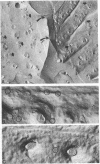Abstract
Conjugation-rescue experiments with two Tetrahymena thermophila mutants (exo-) incapable of exocytosis (SB255, SB258) have been used to dissect regulatory steps in assembly of a functional membrane microdomain, the fusion rosette. "Rescue" refers to the recovery of a secretory activity. Exo- mutants fail to secrete mucus normally (form capsules) when stimulated by the secretagogue alcian blue and are blocked before the assembly of a functional fusion rosette in the cell membrane. Two criteria are used to assay recovery of the wild-type (exo+) phenotype: the conjugant's ability to form capsules when stimulated and the presence of assembled rosettes, which disperse upon stimulation. Conjugation of exo+ X SB258 results in restoration of secretion in 60% of the mutant conjugants and reappearance of assembled rosettes. Secretory capacity is restored in the SB258 cell within one-half hour of firm pair formation. This restoration is not due to new gene expression or continued protein synthesis, since it occurs when SB258 is crossed to a "star" strain (A*), which has defective micronuclei and therefore cannot contribute wild-type genes, and restoration occurs in the presence of cycloheximide during conjugation. Conjugation of exo+ X SB255 reveals a real but inefficient restoration of exocytic capacity in the exo- conjugant and a significant decrease of exocytic capacity in the exo+ conjugant. SB255 X SB258 crosses also show a low but significant rescue of exocytic competence, indicating that different components of the exocytic mechanism are affected in the two mutants. This cross leads to restoration of rosette assembly and function in one of the partners, presumably SB258. These results provide data about some of the steps necessary for rosette assembly and suggest that transferable factors that promote and/or inhibit exocytosis are present in these cells.
Full text
PDF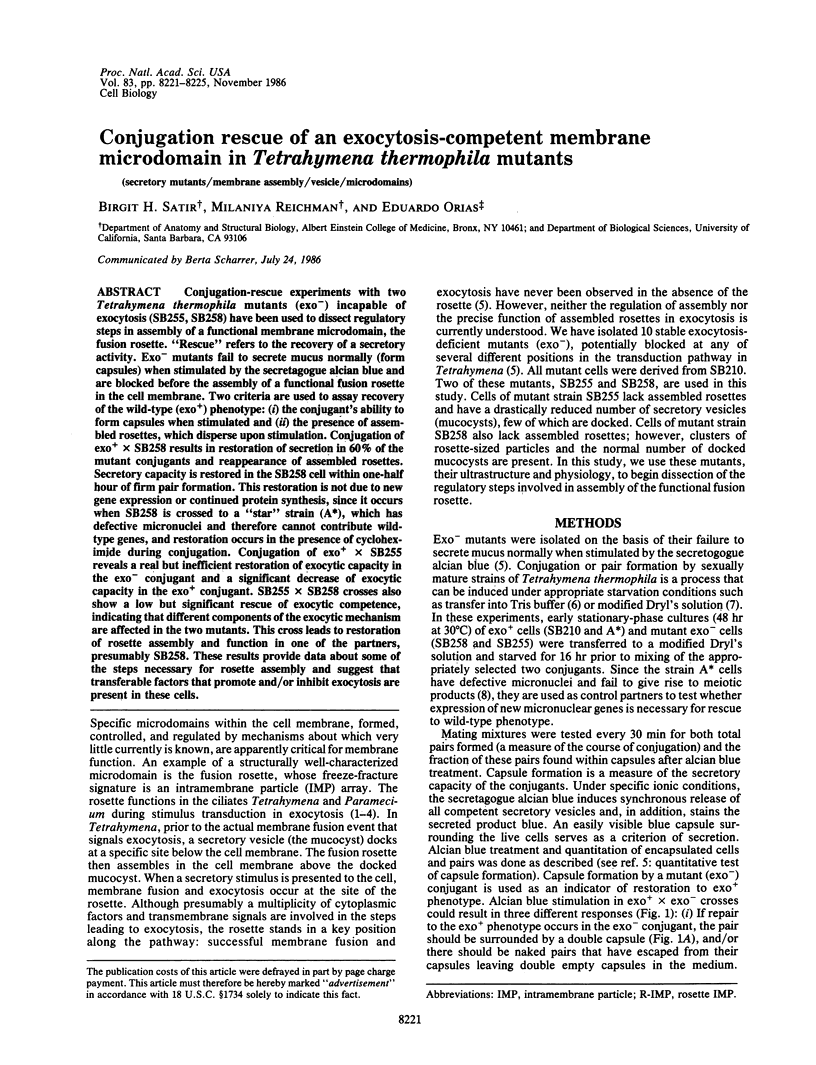
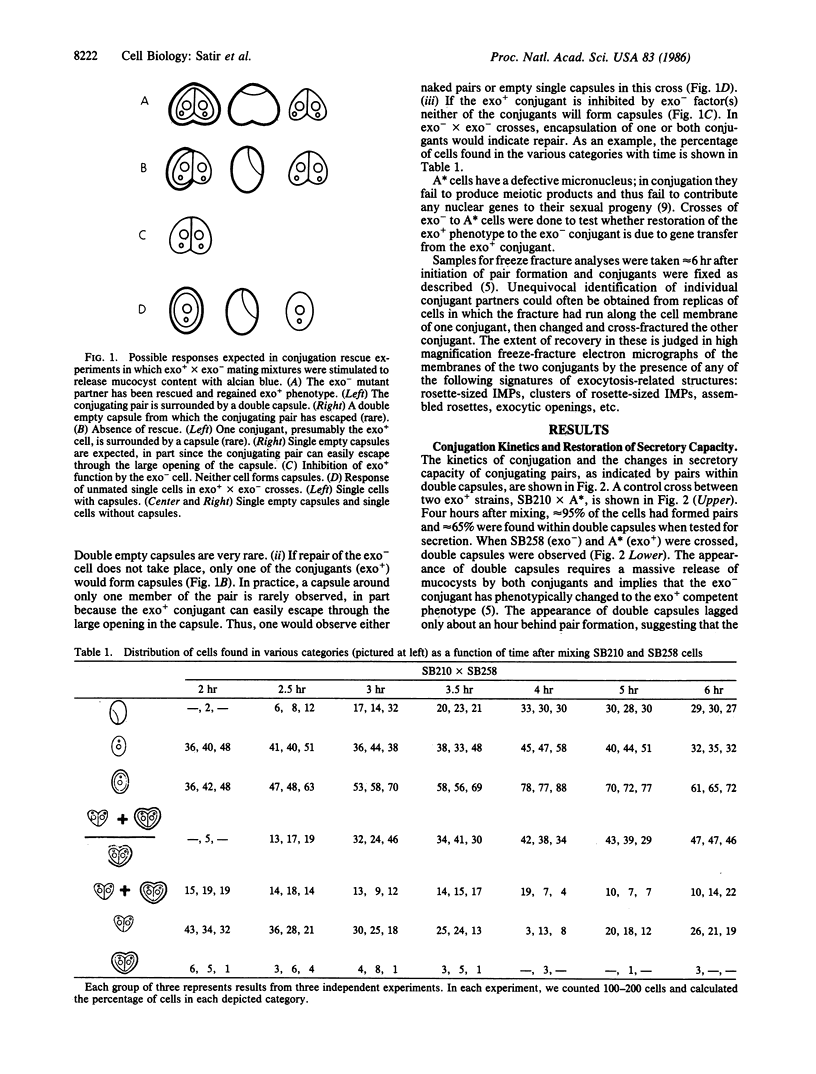
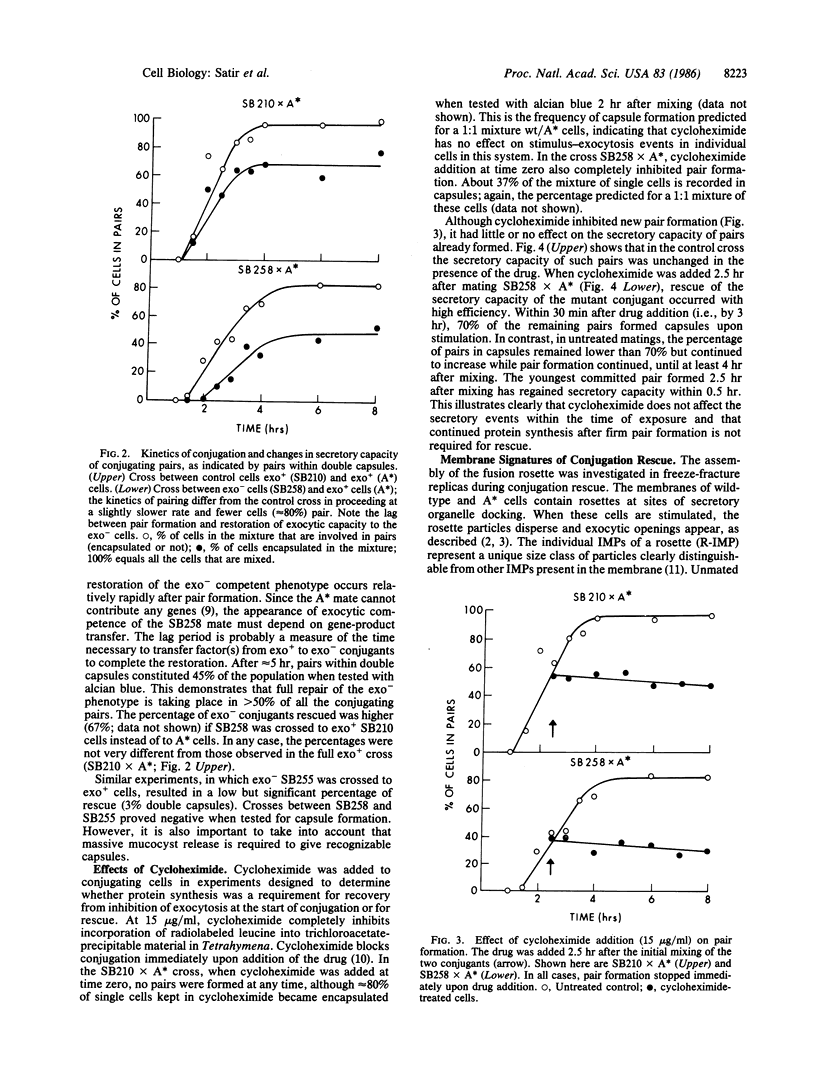
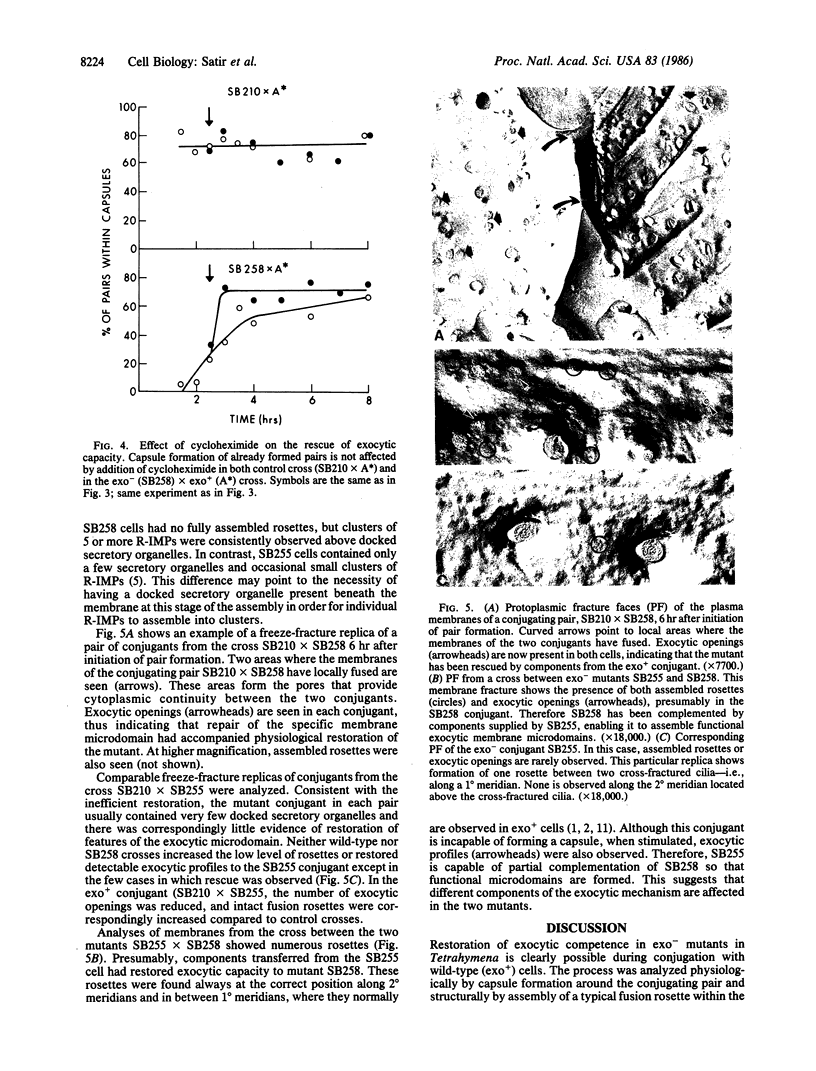
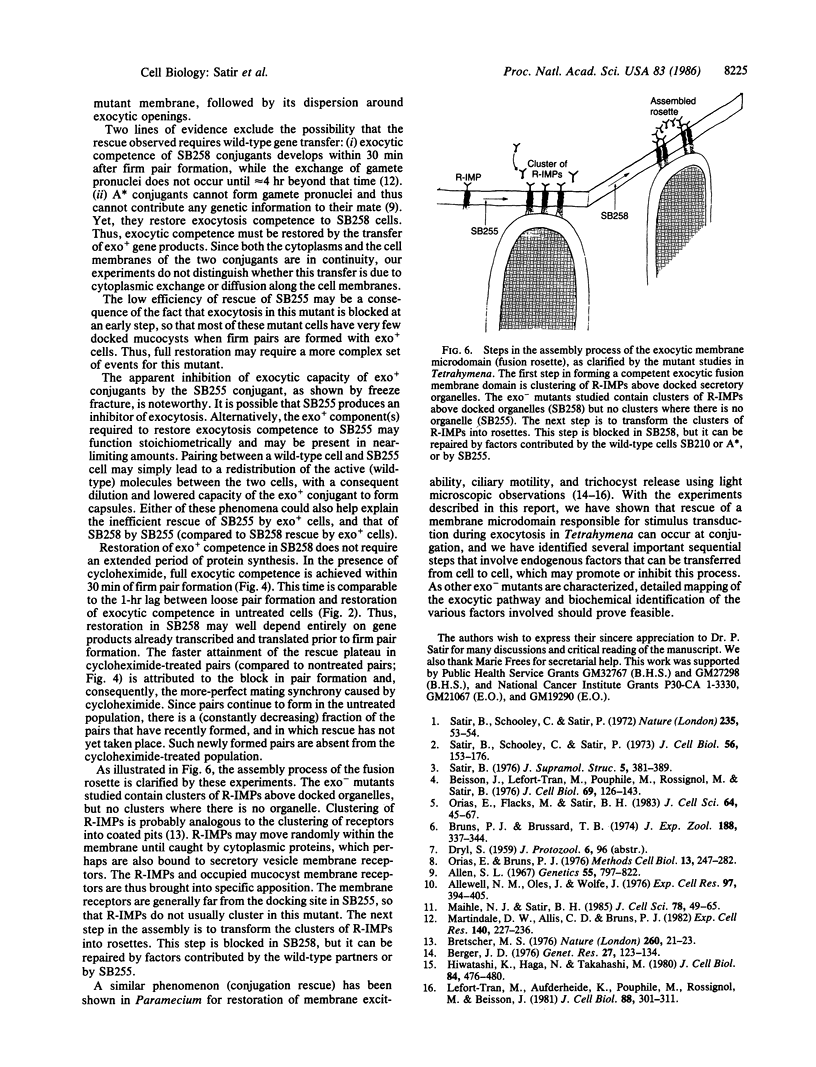
Images in this article
Selected References
These references are in PubMed. This may not be the complete list of references from this article.
- Allen S. L. Cytogenetics of genomic exclusion in Tetrahymena. Genetics. 1967 Apr;55(4):797–822. doi: 10.1093/genetics/55.4.797. [DOI] [PMC free article] [PubMed] [Google Scholar]
- Allewell N. M., Oles J., Wolfe J. A physicochemical analysis of conjugation in Tetrahymena pyriformis. Exp Cell Res. 1976 Feb;97(2):394–405. doi: 10.1016/0014-4827(76)90631-5. [DOI] [PubMed] [Google Scholar]
- Beisson J., Lefort-Tran M., Pouphile M., Rossignol M., Satir B. Genetic analysis of membrane differentiation in Paramecium. Freeze-fracture study of the trichocyst cycle in wild-type and mutant strains. J Cell Biol. 1976 Apr;69(1):126–143. doi: 10.1083/jcb.69.1.126. [DOI] [PMC free article] [PubMed] [Google Scholar]
- Berger J. D. Gene expression and phenotypic change in Paramecium tetraurelia exconjugants. Genet Res. 1976 Apr;27(2):123–134. doi: 10.1017/s0016672300016335. [DOI] [PubMed] [Google Scholar]
- Bretscher M. S. Directed lipid flow in cell membranes. Nature. 1976 Mar 4;260(5546):21–23. doi: 10.1038/260021a0. [DOI] [PubMed] [Google Scholar]
- Bruns P. J., Brussard T. B. Pair formation in tetrahymena pyriformis, an inducible developmental system. J Exp Zool. 1974 Jun;188(3):337–344. doi: 10.1002/jez.1401880309. [DOI] [PubMed] [Google Scholar]
- Hiwatashi K., Haga N., Takahashi M. Restoration of membrane excitability in a behavioral mutant of Paramecium caudatum during conjugation and by microinjection of wild-type cytoplasm. J Cell Biol. 1980 Feb;84(2):476–480. doi: 10.1083/jcb.84.2.476. [DOI] [PMC free article] [PubMed] [Google Scholar]
- Lefort-Tran M., Aufderheide K., Pouphile M., Rossignol M., Beisson J. Control of exocytotic processes: cytological and physiological studies of trichocyst mutants in Paramecium tetraurelia. J Cell Biol. 1981 Feb;88(2):301–311. doi: 10.1083/jcb.88.2.301. [DOI] [PMC free article] [PubMed] [Google Scholar]
- Maihle N. J., Satir B. H. Protein secretion in Tetrahymena thermophila: characterization of the secretory mutant strain SB281. J Cell Sci. 1985 Oct;78:49–65. doi: 10.1242/jcs.78.1.49. [DOI] [PubMed] [Google Scholar]
- Martindale D. W., Allis C. D., Bruns P. J. Conjugation in Tetrahymena thermophila. A temporal analysis of cytological stages. Exp Cell Res. 1982 Jul;140(1):227–236. doi: 10.1016/0014-4827(82)90172-0. [DOI] [PubMed] [Google Scholar]
- Orias E., Bruns P. J. Induction and isolation of mutants in Tetrahymena. Methods Cell Biol. 1976;13:247–282. [PubMed] [Google Scholar]
- Orias E., Flacks M., Satir B. H. Isolation and ultrastructural characterization of secretory mutants of Tetrahymena thermophila. J Cell Sci. 1983 Nov;64:49–67. doi: 10.1242/jcs.64.1.49. [DOI] [PubMed] [Google Scholar]
- Satir B. Genetic control of membrane mosaicism. J Supramol Struct. 1976;5(3):381–389. doi: 10.1002/jss.400050310. [DOI] [PubMed] [Google Scholar]
- Satir B., Schooley C., Satir P. Membrane fusion in a model system. Mucocyst secretion in Tetrahymena. J Cell Biol. 1973 Jan;56(1):153–176. doi: 10.1083/jcb.56.1.153. [DOI] [PMC free article] [PubMed] [Google Scholar]
- Satir B., Schooley C., Satir P. Membrane reorganization during secretion in Tetrahymena. Nature. 1972 Jan 7;235(5332):53–54. doi: 10.1038/235053a0. [DOI] [PubMed] [Google Scholar]



